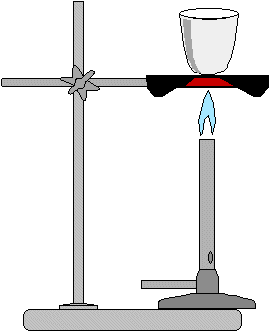Compounds are substances that consist of more than one element chemically bound together. The elements in a compound cannot be physically separated but can only be distinguished by the use of chemical reactions. In this lab you will create a chemical compound from two elements: iron and oxygen. The iron will come from fine steel wool and the oxygen is provided by the metabolism of plants: our atmosphere is about 20% oxygen.
The compound you will make is a common one and you probably know it by the name rust. Rusting is a slow process that, under normal conditions, will take years. We will be speeding it up by doing two things. First, we will soak the steel wool in a solution of ammonium chloride, which creates conditions more conducive to rapid rusting. Second, we will heat the steel wool to dryness after several days of soaking and the heat will carry the reaction to completion.
This process will still take 4 to 7 days to complete so that this lab will extend over more than one lab period. By the end of the lab you will have the mass of iron, and the mass of iron oxide formed from it. This data will be all you need in order to determine the empirical formula of iron oxide.
One class of chemical reactions are called Oxidation/Reduction reactions. The prototypical oxidation reaction is one in which an element combines with oxygen; hence the name. More generally, oxidation reactions occur whenever an element or compounds loses electrons. Reduction reactions are required to separate metals from their ores and are found in such everyday products as rust removers such as Iron Out. When a reaction is classified as a reduction it means that the chemical involved has gained electrons. Oxidation reactions are always accompanied by reduction reactions. The formation of rust is classified as an oxidation reaction: iron loses electrons and oxygen gains electrons.
The exchange of electrons between reagents in this type of reaction is facilitated by a medium which can carry electrons. For example, batteries store potential chemical energy and the reaction can be started by completing a circuit with a wire or device. Batteries are just oxidation/reduction reactions that can be harnessed to provide an electric current. Another way to carry electrons is to carry them indirectly on ions in solution. A simple salt solution is a good carrier of electricity and is therefore a perfect medium for oxidation/reduction reactions. This is the reason that you will use ammonium chloride (the chloride salt of household ammonia) in this lab. The salt in the solution facilitates the exchange of electrons between the iron in the steel wool and the oxygen in the air. Without this electrolyte (a chemist’s name for a solution that carries electricity) the reaction would take far too long. But with the salt solution we can expect all of the iron in the steel wool to rust by the time a week has passed.
If your teacher has not already done so, ask to see a demonstration of the power of electrolyte solutions. Perhaps a lightbulb will turn on.
The following list does not cover all possible hazards, just the ones that can be anticipated. Move slowly and carefully in the lab: haste and impatience have caused more than one accident.
There are three parts to the procedure for this lab. First, you must find the mass of iron and prepare it for a week of rusting. Second, you must monitor the iron during that week and ensure that it stays damp with NH4Cl solution. Third, and finally, you must drive off the remaining NH4Cl solution and complete the rusting of the iron by heating and find the mass of iron oxide.

Now you will use your data to determine the empirical formula of rust. You should collect your data into a neat table showing the mass of the crucible, the mass of steel wool (iron), the mass of the crucible plus iron oxide, and the mass of iron oxide. Additionally, you should add the calculated mass of oxygen which was added to the mass in the crucible and the number of moles of each reagent: iron and oxygen.
Answer these questions in paragraph form in the analysis section of your formal lab write-up.
This lab will result in two different grades. First, each group must coordinate the writing of a single formal lab report per group. If you broke your usual large group into pairs or trios then these smaller groups are the starting point for the lab report. The written report must be in paragraph form and should discuss the results: it should not show all the work.
Second, each individual must produce a final-draft-quality document showing the data, calculations and conclusions of this lab. This document should show all the work required to complete the answers to all of the questions in the Analysis section of the lab report. Include all data tables. It is recommended that you type this assignment but it is not required.
Suggestion: meet with the members of the group that must write the report and work out all of the calculations together, completing the second assignment as described above. Once that is complete, work out how to divide the labor for writing the report. In this way everyone will come to understand the important points of this lab.